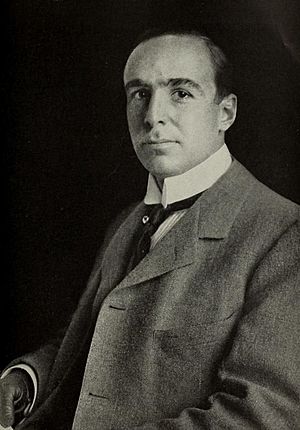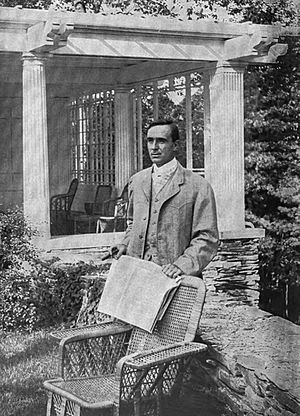Winston Churchill (novelist) facts for kids
Quick facts for kids
Winston Churchill
|
|
|---|---|

Winston Churchill in 1908
|
|
| Born | November 10, 1871 St. Louis, Missouri |
| Died | March 12, 1947 (aged 75) Winter Park, Florida |
| Occupation | Novelist, Writer |
| Nationality | American |
| Genre | |
| Notable works |
|
| Spouse |
Mabel Harlakenden Hall
(m. 1895; |
| Children | 3 |
Winston Churchill (born November 10, 1871 – died March 12, 1947) was a very popular American writer. He wrote many best-selling novels in the early 1900s.
Today, people often confuse him with the famous British leader, also named Winston Churchill. They were not related, even though they shared the same name and some interesting life similarities!
Contents
Early Life and Education
Winston Churchill was born in St. Louis, Missouri. His parents were Edward Spalding Churchill and Emma Bell Blaine. He went to Smith Academy in Missouri.
Later, he attended the United States Naval Academy. He was a very good student there. He was also active in student life. He became an expert at fencing. He even started the first eight-oared rowing team at the Academy. He was the captain for two years.
After graduating in 1894, he worked as an editor. He wrote for the Army and Navy Journal. But he soon left the Navy. He wanted to become a full-time writer. In 1895, he became a managing editor for Cosmopolitan Magazine. However, he left that job quickly. He wanted more time to write his own stories.
Becoming a Famous Writer
Churchill's first novel was The Celebrity (1898). But an earlier story, Mr. Keegan's Elopement, was published in a magazine in 1896. It later came out as a book in 1903.
His next book, Richard Carvel (1899), was a huge hit! It sold about two million copies. This was a lot for a country of 76 million people. This book made him very rich. His next two novels were also very popular. These were The Crisis (1901) and The Crossing (1904).
At first, Churchill wrote historical novels. These stories were set in the past. Later, he started writing about modern America. He often put his ideas about politics into his books.
Life in New Hampshire
In 1898, a large house was built for Churchill. It was in Cornish, New Hampshire. He moved there in 1899. He named his new home Harlakenden House. This house was also used by President Woodrow Wilson as a summer home. Wilson rented it from Churchill from 1913 to 1915.
Churchill became part of the Cornish Art Colony. He also got involved in politics. He was elected to the state legislature in 1903 and 1905. In 1906, he tried to become governor of New Hampshire. He did not win the Republican Party nomination. In 1912, he ran for governor again. This time, he was a candidate for the Progressive Party. He did not win that election either. After that, he did not seek public office again.
In 1917, he visited the battlefields of World War I. He wrote about what he saw. This was his first non-fiction book. Later, he also started painting. He became known for his watercolor landscapes. Some of his paintings are in art museums.
Later Years and Legacy
Churchill's books continued to sell very well. Many of his novels were top best-sellers in America. These included Richard Carvel, The Crisis, The Crossing, Coniston, Mr. Crewe's Career, and The Inside of the Cup.
In 1919, Churchill decided to stop writing novels. He also stepped away from public life. Because of this, people slowly started to forget about him. In 1923, his home, Harlakenden House, burned down. The Churchills then moved to another house nearby.
In 1940, he published The Uncharted Way. This was his first book in twenty years. It was about his thoughts on religion. He did not try to make it famous, so it did not get much attention. Before he died, he said it was hard to think of himself as a novelist anymore. He felt that part of his life belonged to another time.
Death
Winston Churchill passed away in Winter Park, Florida, in 1947. He died from a heart attack. His wife, Mabel Harlakenden Hall, had died two years earlier in 1945. They had been married for fifty years.
A special sign, a New Hampshire historical marker, remembers him. It is located in Cornish, New Hampshire. Churchill and his wife had three children. One of their sons, Creighton Churchill, became a well-known writer about wines.
The Two Winston Churchills
In the 1890s, people started confusing the American Winston Churchill's writings with those of the British writer with the same name. At that time, the American writer was more famous. The British Winston Churchill wrote to him about the confusion.
They decided that the British Churchill would use a different name for his books. He would use "Winston Spencer Churchill." Later, this was shortened to "Winston S. Churchill." This became the British Churchill's pen name. The two men met a couple of times when one was visiting the other's country. However, they were never close friends.
They had some other interesting things in common too. Both men went to military schools. Both also served briefly as officers in their countries' armed forces. One was in the navy, and the other in the army. Both Churchills loved to paint as a hobby. They were also both writers. And both were involved in politics. However, the British Churchill's political career was much more famous and important.
Books by Winston Churchill
Novels
- Mr. Keegan's Elopement (magazine version, 1896)
- The Celebrity (1898)
- Richard Carvel (1899)
- The Crisis (1901)
- Mr. Keegan's Elopement (hardback book, 1903)
- The Crossing (1904)
- Coniston (1906)
- Mr. Crewe's Career (1908)
- A Modern Chronicle (1910)
- The Inside of the Cup (1913)
- A Far Country (1915)
- The Dwelling-Place of Light (1917)
Other Writings and Plays
- Richard Carvel; A play shown on Broadway (1900–1901)
- The Crisis; A play shown on Broadway (1902)
- The Crossing; A play shown on Broadway (1906)
- The Title Mart; A play shown on Broadway (1906)
- A Traveller In War-Time (1918)
- Dr. Jonathan; A play in three acts (1919)
- The Uncharted Way (1940)
Movies Based on His Books
- The Crisis (directed by Colin Campbell, 1916)
- The Dwelling Place of Light (directed by Jack Conway, 1920)
- The Inside of the Cup (directed by Albert Capellani, 1921)


